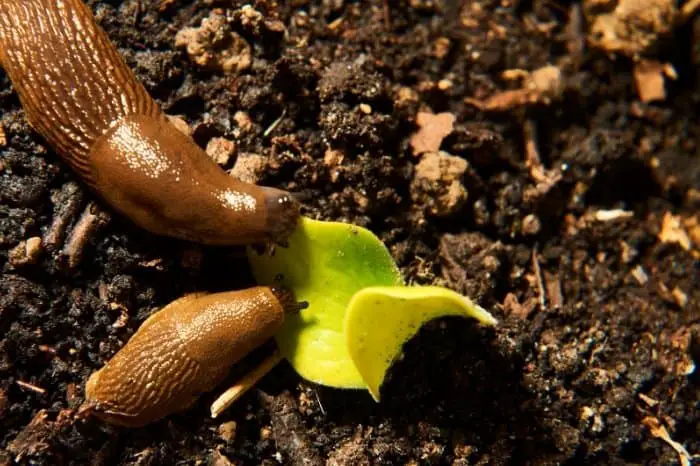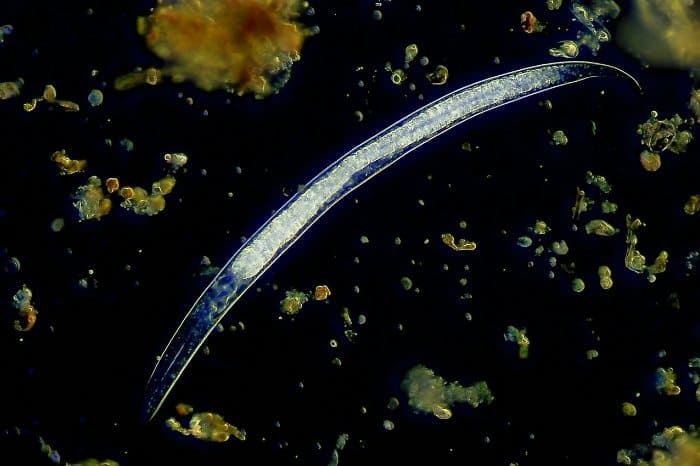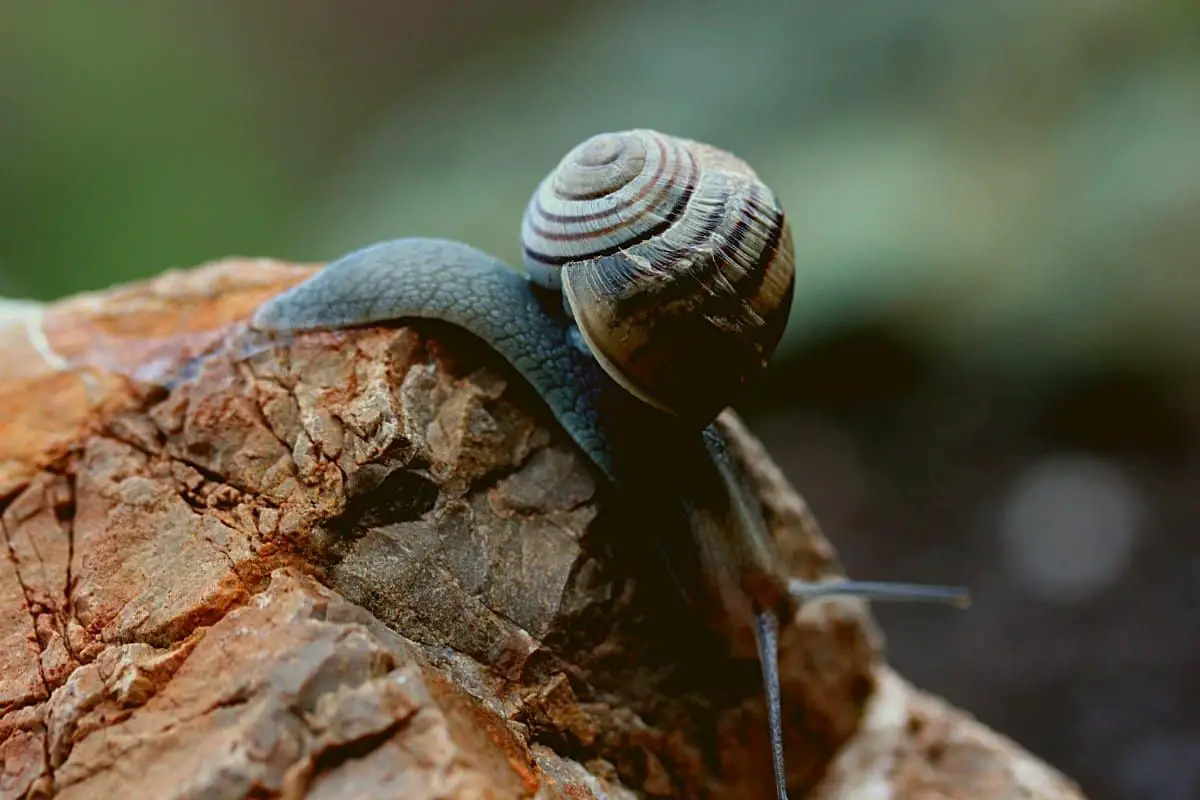Last Updated on February 14, 2022 by
Slugs are not favorite pests to have around; they are just sickening and ugly, but where do slugs come from at night.
These soft-bodied creatures can be as long as 25 to 100mm long. Unlike snails, they do not have shells to hide during harsh conditions. These shells are made of calcium carbonate, and snails get to live in their bodies for several years.
Slugs belong to the phylum Mollusca class and the giant squid, the steamer clam, and periwinkle. Snails and slugs are hermaphroditic, each carries both male and female reproductive organs, yet they still mate.
So, Where Do Slugs Come From At Night?
Snails and slugs emerge from their damp hiding places only when conditions are suitable, after raining or at night. During this time, the air is cooler and much more humid at ground level. This is the main reason why slugs come out at night.

Where Do Slugs Live?
During the day, snails and slugs are often clustered together in damp areas, mostly underneath rocks, stones, and rotten logs. Slugs’ soft bodies are susceptible to drying out because they have no shells.
Snails protect themselves from losing water during certain seasons. Before winter, the snails will secrete a double layer of mucus over the opening of their shell to help reduce water loss. Many types of slugs hibernate by hiding in damp areas for as long as the weather is not friendly. Equally, slugs may not come out of their hiding places during summer in hot, dry regions to avoid losing water.
Identifying Slugs In Your Garden
Most garden slugs are dull orange, grey, or dark brown, measuring at least 1 to 2 inches long. However, what attracts slugs to your garden? Dark shady areas that are moist or damp consistently attract slugs to your garden. They love to come out and feed, so you will most likely see the damage but not catch the culprits.
They have a slimy secretion that they leave behind where they have been. Even if you don’t spot them but find this secretion, you will know you have slugs invading your garden. These secretion trails are best seen in the morning.
If you are not sure slugs are invading your garden, you can trap them using this small activity. Dig holes that are about 4 inches wide and 6 inches deep. Cover them with a board and check for slugs after 3 days. If you see many of them, you get your confirmation of these sneaky pests visiting your garden.
Slugs lay their eggs in the compost or moist soils, and their population grows rapidly in a cool and humid environment.
How To Get Rid Of Slugs That Come At Night
Use Salt
This is the most accessible and affordable method to get rid of slugs. Sprinkle salt on these pesky slugs to kill them but don’t sprinkle it on the plants as it will kill them. It’s best to spread the salt away from your plants.
Use A Beer Trap
An easy and inexpensive way to get rid of slugs is to use a beer trap. Create your beer trap by burying a container halfway near vulnerable plants and half-filling it with beer. Alternatively, you can look for the purpose-made beer traps with the scent of beet to lure slugs away. Keep the container’s rim above the ground about 2- 3 cm to avoid catching slug-eating ground beetles.
Use Plants That Deter Slugs
Even if it means growing these plants on the edges of your garden, do so. This is a gentle method that deters slugs acting as a natural pesticide. This way, you get to keep slugs away without using chemicals. Plants like fennel, rosemary, wormwood, rue, and anise repel slugs.
Destroy The Slugs Shelter
Slugs love to hide under dead logs, garden furniture, or under bricks. Remove these potential slug shelters and expose them to natural predators. By making your garden an unsuitable habitat for slugs, the problem will naturally decline. Also, encourage natural predators like hedgehogs, toads, song crushers, and newts that eat the slugs.
Monterey LG6500 Sluggo Wildlife and Pet Safe Slug Killer, 2.5 lb
Create A Prickly Barrier
Slugs are soft-bodied, and anything prickly will be a significant barrier to keep these pests away from your precious plants. Use pine needles, crushed eggshells, or thorny cuttings to create the obstacles. You can also use sharp sand but ensure it will not alter the soil quality.
Use A Slippery Barrier
This is the best method for potted plants. You can spray a slippery substance on the outside of the plant pots so that the slugs cannot scale them. This effectively protects your container plants.
Lay Down Copper Tape
slugs Lay down the self-adhesive copper tape in your garden to the point where you do not want the slugs to go past. Copper tape reacts with slug slime and gives slugs a tiny electric shock each time exposed to it. It deters the slugs from reaching your plants. You can attach the tape to the greenhouse staging, potted plants, raised beds, or anything that needs protecting from slugs.
Apply Nematodes To The Soil
Nematodes are like soil-dwelling micro-organisms that are parasites to slugs. Mix the nematodes with water and apply them to the soil. The soil temperature should be more than 5C to have this treatment work effectively.

Divert Their Attention
Leave an old pile of lettuce leaves or dries cat food in a damp shady corner to attract the slugs. As they assemble to the food source, scoop them out and dispose of them off in masses. Couple this technique with taking torchlight night walks in your garden to catch slugs on the move.
Go The Eco-Method Way
Being on the lower part of the food chain, the slug can be fed to carnivorous predators that will bring an ecological effect to your garden. Encourage birds, hedgehogs, and badgers into your garden to feed on slugs and reduce their population.
Chickens make excellent pets, and you can feed the slugs you pick from your garden to them. Then you can wait to pick a whole lot of free-range eggs from your slug-fed chicken.
FAQs
How do you permanently get rid of slugs?
Slugs are not an easy thing to kill. I would suggest that you get a slug trap.If you have a garden or a lawn, you can use something called a slug and snail bait. You put the bait down where you want the slugs to go. They will eat the bait and die. The bait is usually some kind of meat, usually a fish based one. Some people will use garlic as their slug and snail bait. You can buy these baits in a variety of flavors. You can buy them in the store or online. You can get them from your local grocery store or big box retailer.
What are slugs attracted to?
Slugs are small, thin-bodied, and slow-moving. They are often mistaken for snails, but they do not have shells, and their bodies are more elongated than snails. Slugs have a variety of predators including birds, dogs, cats, frogs, lizards, snakes, raccoons, and other mammals. Some species will eat other slugs if they are hungry enough.
Slugs are also a favorite food of beetles, grasshoppers, wasps, and ants. Slugs are herbivores and feed primarily on decaying organic matter such as leaves, stems, flowers, fruits, and seeds. Slugs use their tongues to scrape the surface of plant material, removing small particles. They do not chew, but instead swallow their food whole.
What is the lifespan of a slug?
They can live for up to two years. They are also known as snail slugs. The lifespan of a slug is usually from three to five months, but some can survive for up to a year. A: I believe it is about one year.
Are slugs more active at night?
They are more active at night. Also, slugs are a little more active during the cooler hours of the day and during the summer months. They also like moist conditions (think about what a slug likes to eat).
Slugs are found in nearly all of the United States, Canada, and throughout Europe. While they are not considered invasive pests in many areas, slugs do spread disease, such as Botrytis cinerea, which is known as gray mold. Gray mold causes leaves to turn brown and then dry up.
Do slugs need water?
Slugs and snails do not need water to survive. They are able to live without it, but their rate of metabolism is greatly reduced when they don't have access to water. Slugs and snails are members of the phylum Annelida, or segmented worms.
Slugs and snails are generally considered to be a pest because they eat other plants, but some species are actually beneficial, like the milkweed slug (Arionidae). The snail (Gastropoda) is another species of animal that is considered to be a pest.
Does vinegar deter slugs?
You can use anything to deter slugs, but the best results come from chemicals like Sluggo (and Sluggo Jr.) If you don't want to use chemicals, you can try making your own deterrent. Mix one part vinegar with two parts water, and spray on plants.
It will work. It's not 100% effective, but a spray bottle is less effective than a mist or fogger.
Conclusion
FAQs
How do you permanently get rid of slugs?
Slugs are not an easy thing to kill. I would suggest that you get a slug trap.If you have a garden or a lawn, you can use something called a slug and snail bait. You put the bait down where you want the slugs to go. They will eat the bait and die. The bait is usually some kind of meat, usually a fish based one. Some people will use garlic as their slug and snail bait. You can buy these baits in a variety of flavors. You can buy them in the store or online. You can get them from your local grocery store or big box retailer.
What are slugs attracted to?
Slugs are small, thin-bodied, and slow-moving. They are often mistaken for snails, but they do not have shells, and their bodies are more elongated than snails. Slugs have a variety of predators including birds, dogs, cats, frogs, lizards, snakes, raccoons, and other mammals. Some species will eat other slugs if they are hungry enough.
Slugs are also a favorite food of beetles, grasshoppers, wasps, and ants. Slugs are herbivores and feed primarily on decaying organic matter such as leaves, stems, flowers, fruits, and seeds. Slugs use their tongues to scrape the surface of plant material, removing small particles. They do not chew, but instead swallow their food whole.
What is the lifespan of a slug?
They can live for up to two years. They are also known as snail slugs. The lifespan of a slug is usually from three to five months, but some can survive for up to a year. A: I believe it is about one year.
Are slugs more active at night?
They are more active at night. Also, slugs are a little more active during the cooler hours of the day and during the summer months. They also like moist conditions (think about what a slug likes to eat).
Slugs are found in nearly all of the United States, Canada, and throughout Europe. While they are not considered invasive pests in many areas, slugs do spread disease, such as Botrytis cinerea, which is known as gray mold. Gray mold causes leaves to turn brown and then dry up.
Do slugs need water?
Slugs and snails do not need water to survive. They are able to live without it, but their rate of metabolism is greatly reduced when they don't have access to water. Slugs and snails are members of the phylum Annelida, or segmented worms.
Slugs and snails are generally considered to be a pest because they eat other plants, but some species are actually beneficial, like the milkweed slug (Arionidae). The snail (Gastropoda) is another species of animal that is considered to be a pest.
Does vinegar deter slugs?
You can use anything to deter slugs, but the best results come from chemicals like Sluggo (and Sluggo Jr.) If you don't want to use chemicals, you can try making your own deterrent. Mix one part vinegar with two parts water, and spray on plants.
It will work. It's not 100% effective, but a spray bottle is less effective than a mist or fogger.
Now that you know where slugs come from at night and why they do so, you can get rid of these destructive pests.
Caroline is a gardener who loves to get down to the nitty–gritty of gardening. She proudly proclaims herself as a ‘dirt worshipper‘ and can often be found deep in the garden, covered in soil and singing to her plants. As a self–proclaimed ‘plant whisperer‘, Caroline believes that plants need love and attention just like any other living thing, and she loves to give them both. When she‘s not tending to her garden, you can often find her researching the latest gardening trends, or teaching others how to make their gardens thrive



